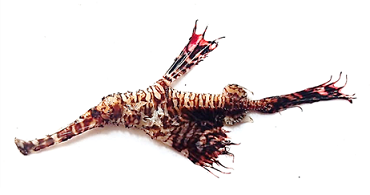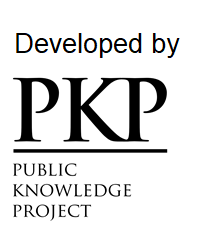First record of ornate ghost pipefish Solenostomus paradoxus from mainland India
DOI:
https://doi.org/10.47193/mafis.3812025010104Keywords:
False pipefish, stellate ossification, supraoccipital ridge, spinules, brood pouch, cryptic camouflageAbstract
This study documents the first occurrence of a female ornate ghost pipefish, Solenostomus paradoxus (Pallas, 1770) from mainland India, collected at a depth of 40 m in the Arabian Sea. It provides the first detailed description of morphometric and meristic characteristics of this species from this region. Due to their small size, effective camouflage, and specific habitat needs, ornate ghost pipefish are challenging to study, and their solitary, seasonal behaviors further complicate research. This work adds valuable knowledge to the limited understanding of this elusive species and highlights the need for further exploration of underrepresented marine biodiversity.
Downloads
Metrics
References
Bannikov AF, Carnevale G. 2017. Eocene ghost pipefishes (Teleostei, Solenostomidae) from Monte Bolca, Italy. Boll Soc Paleontol Ital. 56 (3): 319-331.
Dick K, Pollom R. 2017. Solenostomus paradoxus. [errata version of 2016 assessment]. IUCN Red List of Threatened Species. e.T65363417A115409075.
Jungersen HFE. 1908. Ichthyotomical contributions I. The structure of the genera Amphisile and Centriscus. Kgl. Dansk Vidensk. Skr. 7 R. Afd. 6: 41-109. DOI: https://doi.org/10.5962/bhl.title.130915
Jungersen HFE. 1910 Ichthyotomical contributions: II. The structure of The Aulostomidae, Syngnathidae and Solenostomidae. Mém. Acad. Roy. Sci. Lettr. Danemark. 7 sér. Sect. Sci. 8: 269-363.
Nakabo T. 2002. Introduction of Ichthyology. In: Nakabo T. editor. Fishes of Japan with pictorial keys to the species. Tokyo: Tokai University Press. p. 21-23.
Nelson JS. 2006. Fishes of the world. 4th ed. Hoboken: John Wiley and Sons.
Nelson JS, Grande TC, Wilson MHV. 2016. Fishes of the world. 5th ed. Wiley: Hoboken. 707 p. DOI: https://doi.org/10.1002/9781119174844
Orr JW. 1995. Phylogenetic Relationships of Gasterosteiform Families (Teleostei: Acanthomorpha) [PhD thesis]. Seattle: University of Washington. 811 p.
Orr JW, Fritzsche RA. 1993. Revision of the ghost pipefishes, family Solenostomidae (Teleostei: Syngnathoidei). Copeia. 1: 168-182. DOI: https://doi.org/10.2307/1446307
Orr JW, Fritzsche RA, Randall JE. 2002. Solenostomus halimeda, a new species of ghost pipefish (Teleostei: Gasterosteiformes) from the Indo-Pacific, with a revised key to the known species of the family Solenostomidae. Aqua, J Ichthyol Aquat Biol. 5: 99-108.
Playfair RL, Gunther A. 1866. The fishes of Zanzibar, with a list of the fishes of the whole east coast of Africa. London: John Van Voorst.
Rajan PT, Mishra SS. 2018. Fishes of Andaman and Nicobar Islands: an updated checklist. J Andaman Sci Assoc. 23 (2): 148-181.
Senou H. 2002. Family Solenostomidae. In: Nakabo T. editor. Fishes of Japan with pictorial keys to the species. Tokyo: Tokai University Press. p. 518-519.
Weber M, De Beaufort LF. 1922. The fishes of the Indo-Australian Archipelago. IV. Heteromi, Solenichthyes, Synentognathi, Percesoces, Labyrinthici, Microcyprini. Leiden: E. J. Brill. 410 p. DOI: https://doi.org/10.1163/9789004590199

Published
How to Cite
Issue
Section
License
Copyright (c) 2025 Diana Benjamin, Sijo P. Varghese, Jacob Thomas, Giftson P. C., Solly Solomon, R. Jeyabaskaran

This work is licensed under a Creative Commons Attribution-NonCommercial-ShareAlike 4.0 International License.
Authors of articles published in Marine and Fishery Sciences retain copyright on their articles, except for any third-party images and other materials added by Marine and Fishery Sciences, which are subject to copyright of their respective owners. Authors are therefore free to disseminate and re-publish their articles, subject to any requirements of third-party copyright owners and subject to the original publication being fully cited. Visitors may also download and forward articles subject to the citation requirements. The ability to copy, download, forward or otherwise distribute any materials is always subject to any copyright notices displayed. Copyright notices must be displayed prominently and may not be obliterated, deleted or hidden, totally or partially.
This journal offers authors an Open Access policy. Users are allowed to read, download, copy, distribute, print, search, or link to the full texts of the articles, or use them for any other legal purpose within the Creative Commons 4.0 license (BY-NC-SA), without asking prior permission from the publisher or the author. This is in accordance with the BOAI definition of Open Access.




























